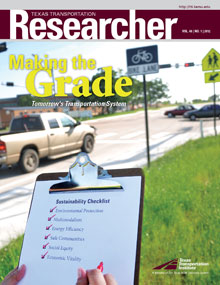A technological revolution is underway that has transportation leaders, government officials and even attorneys abuzz with questions and hope about what it could mean in solving a growing and costly concern — congestion.
Since the early 1980s, the Texas Transportation Institute (TTI) has estimated congestion in hundreds of urban regions across the country. Published annually, the resulting Urban Mobility Report has been the most reliable source of congestion information available.
Although Institute researchers will continue publishing this report, the way they received their congestion data dramatically changed two years ago.
“Up until recently, congestion data were gathered from public sources,” Shawn Turner, head of TTI’s Mobility Division, explains. “Cities and state departments of transportation gathered that information themselves using sporadic traffic counters, a limited number of roadway sensors and a lot of estimations.”
Those methods seem primitive today compared to what is available from the private sector — real-time data thanks to global positioning system and Bluetooth® devices that are contained within many vehicles, cell phones and mobile devices. Traffic-monitoring companies receive data from the devices and can monitor actual speeds and travel times with ever-increasing accuracy on any major highway across the country — not just in urban areas. The data they collect are sold to auto manufacturers, fleet management companies, vehicle navigation firms and, now on a limited basis, government agencies.
TTI has just completed a report for the Federal Highway Administration (FHWA) that examines this new technology — the growing number of companies that collect the data, how the data are collected, the products used in collecting the data, who’s buying the data and how much the data cost, how the data are being used, and the legal issues surrounding use of private-sector data by the public sector. Private Sector Data for Performance Management will act as FHWA’s guide in assisting states and the federal government in using this information to manage/reduce congestion.
“FHWA really wanted to know everything it could about these new, private data sources,” Turner says. “It has been charged with knowing what the congestion problems are and where they are, and recommending where the money should go to help fix it.” Turner adds that the next transportation authorization bill will likely require a much more detailed level of congestion data for performance monitoring.
In addition to TTI, the University of Maryland and attorneys from the law firm of Nossaman, LLP, helped with the report.
“It’s clear that the technology is changing dramatically, and there are numerous questions about its use and application. The report is a starting point for FHWA,” Turner says. “It’s an exciting time because it’s entirely possible that a newer technology will emerge that will make this data collection method obsolete within a few years.”

